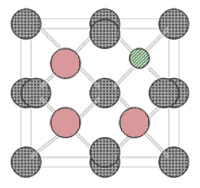Electronic and vibrational properties of Semiconductors
Fig. 1. Anomalous band gap variation
in III-N-V: Role of nitrogen

Fig. 2. Various possible defect centers
in dilute GaNAs

(a) Isolated NAs defect

(b) NAs-AsGa complex

(c) Off center N-As complex
Novel GaInNAs Laser Materials
Photo-detectors, modulators, amplifiers and long wavelength vertical cavity surface emitting lasers (LW-VCSELs) are important light sources used for large capacity optical communication and optical interconnect systems. These devices exhibit, in general, such advantages as low threshold currents, single mode operation, high coupling efficiencies into optical fiber, and high speed modulation.
While InP-based materials have been the source for long reach applications, their cost is still too high to meet the demands for designing a high volume modern data communication networks. Along with scientists and engineers from around the world we are in the search for new low cost laser diodes for operations in the 1.3-1.55 mm range with a minimal loss and dispersion. Epitaxially grown dilute Ga1-xInxNyAs1-y/GaAs III-V-N alloys has revealed important electronic properties which could prove decisive in the race to cover the desired wavelength range and to meet the challenge for low-cost devices to be operated over a significant temperature range (-10 to 85 oC) with moderate power >Besides the technological interests, the basic properties of Ga1-xInx(Alx)NyAs1-y/GaAs materials are equally interesting and intriguing.
Clearly, the choice of varying N and In, Ga(Al) composition has provided the flexibility of simultaneously controlling both the electronic and optical properties. The knowledge of atomic structure and bonding mechanism especially the redistribution of In-N, Ga-N(Al-N) bonds in GaIn(Al)NAs by increasing In, Ga(Al) contents and/or upon rapid thermal annealing is crucial for improving the crystal quality and understanding their distinctive behaviors.
By involving undergraduate and graduate students we have provided a comprehensive analysis of the local mode spectroscopy data using lattice dynamical theories within the Greens function formalism and performed group-theoretical analysis by simulating the effects of N and In,Ga(Al) to investigate the microscopic lattice structures of different configurations (see Fig. 1) in dilute Ga1-xInx(Alx)NyAs1-y alloys. Our approach has allowed us the coupling of defect vibrations to the bulk crystal by providing a clear visualization of those modes which remained localized around defect(s). Unlike ab initio calculations, the Greens function approach is found to be quite sensitive for monitoring the changes in the impurity mode frequencies with the variations in the local bond configurations.